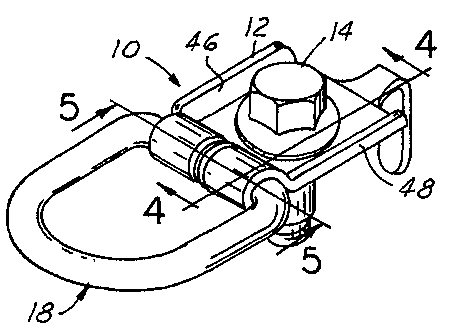Some of the information on this Web page has been provided by external sources. The Government of Canada is not responsible for the accuracy, reliability or currency of the information supplied by external sources. Users wishing to rely upon this information should consult directly with the source of the information. Content provided by external sources is not subject to official languages, privacy and accessibility requirements.
Any discrepancies in the text and image of the Claims and Abstract are due to differing posting times. Text of the Claims and Abstract are posted:
| (12) Patent: | (11) CA 2398830 |
|---|---|
| (54) English Title: | CARGO RESTRAINT DEVICE |
| (54) French Title: | DISPOSITIF DE RETENUE DE CHARGE |
| Status: | Term Expired - Post Grant Beyond Limit |
| (51) International Patent Classification (IPC): |
|
|---|---|
| (72) Inventors : |
|
| (73) Owners : |
|
| (71) Applicants : |
|
| (74) Agent: | MACRAE & CO. |
| (74) Associate agent: | |
| (45) Issued: | 2008-01-15 |
| (86) PCT Filing Date: | 2001-02-21 |
| (87) Open to Public Inspection: | 2001-08-30 |
| Examination requested: | 2005-11-22 |
| Availability of licence: | N/A |
| Dedicated to the Public: | N/A |
| (25) Language of filing: | English |
| Patent Cooperation Treaty (PCT): | Yes |
|---|---|
| (86) PCT Filing Number: | PCT/US2001/005631 |
| (87) International Publication Number: | US2001005631 |
| (85) National Entry: | 2002-07-29 |
| (30) Application Priority Data: | ||||||
|---|---|---|---|---|---|---|
|
A cargo restraint has a D-ring
(18) with cold-headed opposed end portions (26,
28) spaced slightly apart and trapped in a gap
in a passageway (40) of an anchor bracket and
tensioned against edges of the gap to prevent
rattling and withdrawal of the ends of the D-ring
(18) out of the bracket.
Une retenue de charge a un anneau en forme de D (18) doté de portions d'extrémités opposées (26, 28) frappées à froid, légèrement séparées, coincées dans un trou d'une voie de passage (40) d'un point d'ancrage et tendues contre les bords du trou afin d'éviter le bruit et le retrait des extrémités de l'anneau en D (18) hors dudit point.
Note: Claims are shown in the official language in which they were submitted.
Note: Descriptions are shown in the official language in which they were submitted.

2024-08-01:As part of the Next Generation Patents (NGP) transition, the Canadian Patents Database (CPD) now contains a more detailed Event History, which replicates the Event Log of our new back-office solution.
Please note that "Inactive:" events refers to events no longer in use in our new back-office solution.
For a clearer understanding of the status of the application/patent presented on this page, the site Disclaimer , as well as the definitions for Patent , Event History , Maintenance Fee and Payment History should be consulted.
| Description | Date |
|---|---|
| Inactive: Expired (new Act pat) | 2021-02-22 |
| Common Representative Appointed | 2019-10-30 |
| Common Representative Appointed | 2019-10-30 |
| Inactive: Late MF processed | 2010-03-03 |
| Letter Sent | 2010-02-22 |
| Grant by Issuance | 2008-01-15 |
| Inactive: Cover page published | 2008-01-14 |
| Pre-grant | 2007-10-30 |
| Inactive: Final fee received | 2007-10-30 |
| Notice of Allowance is Issued | 2007-09-10 |
| Letter Sent | 2007-09-10 |
| Notice of Allowance is Issued | 2007-09-10 |
| Inactive: Approved for allowance (AFA) | 2007-07-31 |
| Inactive: IPC from MCD | 2006-03-12 |
| Letter Sent | 2005-12-01 |
| Request for Examination Requirements Determined Compliant | 2005-11-22 |
| All Requirements for Examination Determined Compliant | 2005-11-22 |
| Request for Examination Received | 2005-11-22 |
| Letter Sent | 2003-02-28 |
| Inactive: Single transfer | 2003-01-03 |
| Inactive: Courtesy letter - Evidence | 2002-12-17 |
| Inactive: Cover page published | 2002-12-11 |
| Inactive: Notice - National entry - No RFE | 2002-12-09 |
| Application Received - PCT | 2002-09-27 |
| National Entry Requirements Determined Compliant | 2002-07-29 |
| Application Published (Open to Public Inspection) | 2001-08-30 |
There is no abandonment history.
The last payment was received on 2007-01-11
Note : If the full payment has not been received on or before the date indicated, a further fee may be required which may be one of the following
Patent fees are adjusted on the 1st of January every year. The amounts above are the current amounts if received by December 31 of the current year.
Please refer to the CIPO
Patent Fees
web page to see all current fee amounts.
Note: Records showing the ownership history in alphabetical order.
| Current Owners on Record |
|---|
| M & C CORPORATION |
| Past Owners on Record |
|---|
| DONALD M. AUSTIN |